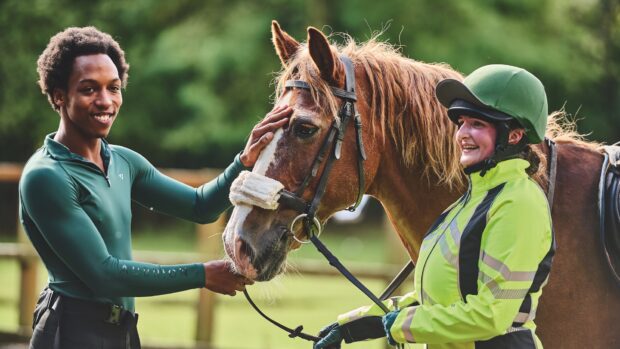We are all responsible when it comes to recognising and managing concussion, was the message from a recent conference on the condition.
The Injured Jockeys Fund (IJF) and British Equestrian (BEF) jointly hosted the inaugural cross-industry concussion symposium at Cheltenham racecourse (27 October). The key point made was the need for a collaborative commitment to concussion education, across the equestrian and racing worlds.
“Racing is fortunate in that we have over 20 years of awareness as to the implications of concussion and we are very keen to share those learnings and best practice with other equestrian disciplines,” said IJF chief executive Lisa Hancock.
“What was so encouraging today is that while we all know the logistical challenges this creates, everyone seems to want to work together using education and communication to improve things for the 1.8m people that ride, regardless of skill, age or discipline.”
IJF chairman William Norris KC added that the charity is “very well placed” to help others in equestrian sport develop and follow good practice.
“Everyone needs to understand and follow good practice, partly because it’s the right thing to do and partly because that is the way in which they can discharge their legal duty of care,” he said. “It won’t be an overnight fix; it is a question of developing ways of educating and sharing our experiences across equestrian sport generally.”
Racing has specific guidelines surrounding identifying concussions, baseline testing and recovery – but these only apply to jockeys. The BEF introduced general concussion guidance for all equestrians this year (2 March).
British Horseracing Authority (BHA) chief medical adviser Dr Jerry Hill stressed the importance of promoting “collective responsibility”.
“You can’t have medical staff being the only people concerned,” said Dr Hill. “You need the support of other colleagues across the equestrian spectrum, particularly decision-makers and funders, as some of the changes we need are structural. If you are the doctor, or first-aider, you need the support of the organisation behind you.”
Anna Louise-Mackinnon, lead medical advisor at the IJF and the BEF’s chief medical officer, added: “One of the key issues is that concussion is largely invisible, and it is often not treated in the same way as a broken limb. And yet correct diagnosis and recovery are vital to the rider being able to return to safely continue participating in their sport in whatever they do and at whatever level.”
A change of attitude from riders trying to “beat the doctor” by attempting to “cover it up”, to understanding how times have changed and using help on hand, particularly at the IJF’s centres, was also raised.
One cost-effective suggestion was to have cross-discipline social media campaigns.
Racing industry concussion practitioner Rosy Hyman said: “We know that if you return too quickly, you are at a much higher risk of another injury. So, the key focus must be what we call the four Rs – recognise (the signs and symptoms); remove (the injured person from all horse-related activities); recover (until all symptoms have been resolved); return (to ridden activity through a gradual, stepwise process).”
Concussion: ‘ongoing collaboration needed’
British Equestrian Trade Association chief medical officer Dr Diane Fisher told H&H that as a major trauma consultant, she welcomes the new collaborative attitude within the industry.
“It’s been a very long time coming in equestrian sport,” she said. “Traumatic brain injuries are at best temporary in the form of concussion and at worst life-ending or life-changing. Shared learning is vital to ensure the best advice, guidance and care can be given consistently across disciplines.
“I can tell you that there is nothing more soul-destroying than answering the, ‘what if’ questions from patients and their families when preventable injuries occur or are more serious than they may have been if readily available safety equipment had been used or correct assessment treatment and guidance had been followed, or both.”
She added: “It is not however enough to publish a guideline and hope it changes behaviour and attitude to injury. It is an important first step.
“There is a professional and personal accountability to actually deliver. Embedding the advice will need ongoing collaboration, consistent messaging and training across the board.”
- What do you think? Send your thoughts to hhletters@futurenet.com, including your name, nearest town and country, and for the chance for your letter to appear in the magazine
You might also be interested in:

Subscribe to Horse & Hound magazine today – and enjoy unlimited website access all year round

New concussion evidence marks ‘momentous milestone’ in rider safety

Groundbreaking concussion and return to riding guidelines released

Virtual reality headsets to be trialled in managing riding-related concussions
Horse & Hound magazine, out every Thursday, is packed with all the latest news and reports, as well as interviews, specials, nostalgia, vet and training advice. Find how you can enjoy the magazine delivered to your door every week, plus options to upgrade your subscription to access our online service that brings you breaking news and reports as well as other benefits.



